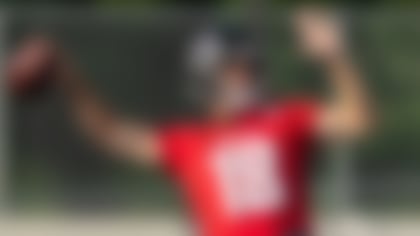The idea that Mark Sanchez could undergo a career revival in Philly wasn't hatched this week.
The Jets washout drew the attention of Eagles decision-makers -- beyond just what prompted his signing -- by the time he got to camp. His solid play in the preseason led to speculation he could be dealt near the final roster cutdown. The ability that once made him the fifth overall pick in the draft was once again apparent.
What no one knew then is if he'd get a shot to show whether all this was real or not.
Harrison: Week 10 predictions
Now, thanks to Nick Foles' misfortune, Sanchez is getting that opportunity, with a prime-time game against the Carolina Panthers on tap Monday night. And smart folks around the league see a player who's primed to prove his days as an NFL starter aren't yet over.
"He's a better fit for (Chip Kelly's offense) than Foles," one NFC pro scouting director said.
Why? Well, there's the fact that he moves better than Foles, which is always the obvious thing to look at with Kelly quarterbacks. But it's more than just that.
Sanchez is viewed as a rhythm passer, the kind who's at his best when he's playing fast. And that doesn't mean running fast, but making decisions quickly, getting the ball out of his hands swiftly and stacking completions on top of completions.
In Brian Schottenheimer's scheme -- which Sanchez did have some success running over three years in New York -- the mental load on the quarterback can be daunting. Especially for a young player. And while he might not say it himself, plenty of those there during that time felt like the more the Jets put on Sanchez, as he went from rookie to sophomore to third-year vet, the more he got weighed down.
By Year 4, he had a new coordinator, in Tony Sparano, and a team that was losing its way. In Year 5, he was injured in the preseason, unceremoniously ending a QB competition against Geno Smith. And while the Jets ranked in the top five in rushing offense during Sanchez's firsttwo years, they were 22nd and 12th the next two years, while slowly bleeding the talent both in front of him and at his disposal in the passing game.
"When he was at his best in New York, he had a good run game and weapons," an AFC personnel executive said. "And what do you know? He has a good run game and weapons in Philly."
This isn't to make excuses for Sanchez's fall in Florham Park. He didn't play well enough to warrant the franchise hitching its wagon to him, not with a 13:18 TD-to-INT ratio in his final year starting there, punctuated by an unsightly December during which he posted passer ratings of 21.4, 79.1, 32.6 and 55.1.
But, as is the case with any quarterback -- from Manning and Brady to Mettenberger and Bortles -- environment has to be considered. Sanchez's worsened as time went on in New Jersey and, at least on the surface, is a lot better now. So too (again, on the surface) is the fit, with a quarterback who was never quite able to fully get his footing as a Jet now in a place that should give him the best shot to find the rhythm that often showed up late in big games in his early years.
"That offense allows for that, because it's quick reads, and it spreads the field well for very clear reads that force declarations from the defense," said the AFC exec. The NFC pro scouting director added, "Things were constantly changing on him (in New York). This should help."
Maybe it'll work out for Sanchez. Maybe it won't. But at the very least, we should get a clearer picture of who he is as an NFL quarterback.
Adding five quick-hitting Week 10 nuggets after spending most of this week on the shelf, for life reasons. (My full "Inside The NFL Notebook" will return next week.)
1) The Houston Texans' decision to move from Ryan Fitzpatrick to Ryan Mallett isn't just to give the offense a spark. It's to get a clear evaluation of the position going forward. And for that reason, it would hardly be shocking to see rookie Tom Savage get a start or two before the year is out. Despite Mallett's struggles in preseason action over the last four years -- and the fact that the New England Patriots were close to cutting him a couple months ago -- the opportunity to see the 26-year-old in live action is worthwhile for a Houston team that clearly is at least a year or two away from meeting Bill O'Brien's vision. Mallett brings size, arm talent and field vision that Fitzpatrick simply couldn't, and that should help this offense get more out of a pretty competent group of skill players. And as one Texans source says, "It's not like he's been in the line of fire, but he's been in (O'Brien's system) for four years (in New England and Houston), so hopefully that counts for something." Since arriving in September, Mallett has shown a willingness to work long hours, and displayed command of the offense and huddle in practice. In short, the way the Texans see it, he deserved the shot. The flip side of this is that Mallett is put in the best possible spot to succeed -- with a strong run game, receiver tandem and knowledge of the scheme -- going into the final months of his rookie contract. So, as is the case with Sanchez, we should have a cleaner evaluation of Mallett at the end of the calendar year.
2) Speaking of the Texans, it's worth paying attention to what Jadeveon Clowney is saying about his knee issues. One of the concerns with the first overall pick back in the spring was that he was such a "kinetic" athlete that he'd be predisposed to soft-tissue injuries. Sure enough, in his first NFL game, he hit a soft spot in the rugged NRG Stadium turf and suffered a meniscus injury that's lingered. In April, Clowney's off-the-charts score on the "force plate" test, administered by the Atlanta Falcons, garnered a lot of headlines. But clubs were just as interested to hear what else was found about his physical makeup. Dr. Phil Wagner, who created the test, told me then that, "(Clowney's) movement signature validates that he's both very physically gifted and physically resilient. What we found is he's not a large injury risk, and he certainly has a lot of tools." Hearing that would be encouraging to teams, but the fact that it was even brought up shows there was a level of concern.
3) If the next eight-plus weeks play out a certain way, there could be a hot offseason market for quarterbacks for the first time in a long time. Both Sanchez and Mallett have their aforementioned opportunities, as does Cleveland Browns QB Brian Hoyer. Hoyer will be 29, Sanchez will be 28 and Mallett will be 26 when the 2015 league year starts. Barring new deals with their current teams, those three will hit free agency. It's too early to tell where these guys could land, if they do venture into the open market. But there are a number of clubs to keep an eye on, especially the ones that could throw in the towel on a young passer and dip into the veteran QB pool. Among those: the Bills, Jets, Buccaneers and Rams. Three of the four have rosters that could contend with better quarterback play, and the exception (New York) might be on the verge of an organizational overhaul.
4) Adrian Peterson and Ray Rice have been clustered together since September, but the potential re-entry of the two into NFL play shouldn't be, because their situations simply aren't the same. And a lot of that has to do with the on-field value of each guy. Callous to look at it that way? Sure it is. There are much bigger issues at work here than who gets to play in football games. But that's the reality of it. NFL front offices and coaching staffs look at red-flagged players like this: Is he worth it? So if Rice is reinstated, that's how he'll be evaluated. The fact is, he plays a devalued position, has six years of wear on his tires, and is coming off the worst season of his career. And he's a free agent. Most people around the league, or at least the ones I've talked to, think Rice might have a chance to get back in next year, but not before then. Peterson, on the other hand, is a transcendent talent who's proven his staying power, and a guy playing for a team that's on the fringe of contention with a rookie quarterback who could use a force like No. 28 to take the heat off. Privately, the coaches there are hoping to get him back in the fold. So again, there are bigger issues to worry about here, obviously. But the question of whether either one (or Greg Hardy) will get a shot to play this year rides in part on how good they are.
5) Wrote last week about Ben Roethlisberger's renaissance under Todd Haley's wing, and there is another aspect to it that deserves time: GM Kevin Colbert's hot hand in drafting receivers over the last few years. The top three wideouts on Pittsburgh's last championship team were Santonio Holmes, Hines Ward and Nate Washington. In the time since, Pittsburgh has spent seven picks on receivers: three third-round picks, a fourth-rounder, two sixth-rounders and a seventh-rounder, with none selected higher than 79th overall. On the first run-through, Colbert built the game's premier young receiver group in Mike Wallace, Antonio Brown and Emmanuel Sanders. And when a cap squeeze forced the GM to pick one (and obviously, there's some culpability there within the team), he extended Brown and found Markus Wheaton and Martavis Bryant to replace the other two. Pretty impressive, all the way around.
Follow Albert Breer on Twitter @AlbertBreer.



